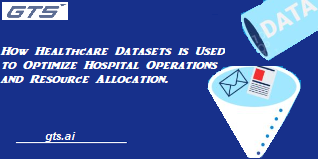How Healthcare Datasets is Used to Optimize Hospital Operations and Resource Allocation.
In recent years, healthcare organizations have increasingly turned to data analytics to optimize their operations and resource allocation. By analyzing healthcare datasets, hospitals can gain insights into patient needs, improve the efficiency of their operations, and allocate resources more effectively. In this blog, we will explore how healthcare datasets are used to optimize hospital operations and resource allocation.
What is a Healthcare Dataset?
A healthcare dataset is a collection of structured or unstructured data that is generated during the course of patient care. It includes information on patient demographics, medical history, diagnosis, treatment, and outcomes. This data is typically collected by electronic health record (EHR) systems and other healthcare information management systems.
How Healthcare Datasets are Used to Optimize Hospital Operations?
- Patient flow optimization:
By analyzing patient data, hospitals can identify bottlenecks in the patient flow process, such as long wait times or delays in test results. With this information, hospitals can optimize their processes and procedures to reduce wait times, improve patient satisfaction, and increase efficiency.
- Staffing optimization:
Hospitals can use healthcare datasets to analyze staffing needs based on patient volumes and acuity levels. This helps hospitals allocate their resources more effectively and ensures that they have the appropriate staffing levels to meet patient needs.
- Resource allocation optimization:
Hospitals can also use healthcare datasets to optimize their resource allocation. For example, by analyzing patient data, hospitals can identify trends in patient needs, such as increased demand for certain services or medications. This allows hospitals to allocate their resources more effectively, ensuring that they have the necessary equipment, supplies, and medications to meet patient needs.
- Predictive analytics:
Predictive analytics can be used to forecast patient demand and identify potential issues before they become problems. By analyzing healthcare datasets, hospitals can identify patients who are at risk of complications or readmissions, allowing them to intervene early and prevent unnecessary hospitalizations.
- Cost optimization:
Hospitals can use healthcare datasets to analyze the cost of care and identify areas where costs can be reduced. For example, by identifying high-cost procedures or medications, hospitals can work to negotiate better prices with suppliers or identify alternative treatment options that are more cost-effective.
How Healthcare Datasets are Used to Optimize Resource Allocation?
- Patient acuity levels:
By analyzing healthcare datasets, hospitals can identify patient acuity levels and allocate resources accordingly. For example, patients with higher acuity levels may require more staff or specialized equipment, while patients with lower acuity levels may require less intensive care.
- Equipment allocation:
Healthcare datasets can also be used to optimize equipment allocation. By analyzing equipment usage data, hospitals can identify trends in equipment demand and allocate equipment more effectively. This ensures that the necessary equipment is available when needed and reduces the risk of equipment downtime or shortages.
- Medication allocation:
Hospitals can use healthcare datasets to optimize medication allocation. By analyzing medication usage data, hospitals can identify trends in medication demand and ensure that they have the necessary medications on hand. This helps to prevent medication shortages or delays in treatment.
- Staff allocation:
Healthcare datasets can also be used to optimize staff allocation. By analyzing staffing data, hospitals can identify staffing needs based on patient volumes and acuity levels. This ensures that they have the appropriate staffing levels to meet patient needs.
- Bed allocation:
Healthcare datasets can be used to optimize bed allocation. By analyzing patient data, hospitals can identify trends in patient demand and allocate beds more effectively. This ensures that beds are available when needed and reduces the risk of overcrowding or delays in treatment.
Conclusion
In conclusion, healthcare datasets are a valuable tool for optimizing hospital operations and resource allocation. By analyzing patient data, hospitals can identify trends in patient demand, optimize their processes and procedures, and allocate resources more effectively. This leads to improved patient outcomes, increased efficiency, and reduced costs. However, it is important to note that the use of healthcare datasets also raises ethical and privacy concerns. Healthcare organizations must ensure that patient data is kept confidential and used only for legitimate purposes. They must also be transparent with patients about how their data is being used and obtain their informed consent.
In addition to these considerations, healthcare organizations must also ensure that their data analytics initiatives are aligned with their overall strategic goals. This means that they must carefully consider which data to collect, how to analyze it, and how to use the insights gained from the analysis to drive meaningful change.
Finally, it is important to note that the use of healthcare datasets is still a relatively new field, and there is much that we still do not know. As such, it is important for healthcare organizations to continually evaluate and refine their data analytics initiatives to ensure that they are effective and aligned with their goals.
In conclusion, the use of healthcare datasets to optimize hospital operations and resource allocation is a powerful tool that can lead to improved patient outcomes, increased efficiency, and reduced costs. However, healthcare organizations must carefully consider the ethical and privacy implications of data collection and use, ensure that their data analytics initiatives are aligned with their overall strategic goals, and continually evaluate and refine their initiatives to ensure that they are effective. With careful planning and execution, healthcare organizations can leverage the power of healthcare datasets to transform the way they deliver care and improve patient outcomes.
How GTS can help you?
AI has already transformed medicine by analyzing enormous amounts of data to identify patterns and insights that can save lives. The explosion of data at our fingertips is by far today’s biggest fuel source for AI development. At the same time, we are rapidly consuming that data and developing machine learning algorithms to filter through it, detect patterns, and apply it forward. And that’s why we at Global Technology Solutions understand your need for healthcare datasets for machine learning. Our services includes data annotation and data collection services to match your needs.




Comments
Post a Comment